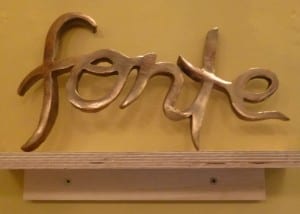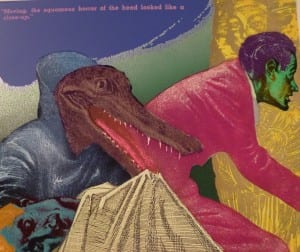Specimen of the Week: Week 143
By zcqsrti, on 7 July 2014
For this week, it’s my turn to step up to the ravenous hoard of knowledge-hungry blog followers (that’s you fantastic lot). But first, before I am ripped apart in a gladiator-esque fashion, I’d like to take this opportunity to introduce myself; Hi all, I am Rowan. I am currently acting as Visitor Services Assistant on a temporary basis, so my time with you shall be unfortunately short yet sweet. So do drop in and you can see me at the front desk fumbling around in childlike wonder at all the amazingly weird thingies the Grant Museum has to offer.
I’ve decided to choose a specimen who will always hold a special place in my heart, having been paired with this sullen looking creature during one of my zoological assignments this year (I’ve just finished the second year of my UCL Natural Sciences degree). One of us was tasked to identify the other, yet I’m still unsure as to who (between me and this fine critter) actually did any effective identification as I spent most of my time confusedly prodding and pestering this specimen; a scientific method which I can only professionally describe as “faffing around”.
Sadly, this specimen is a little lonely having been blessed with an underwhelming greyish-brown and mistakenly ugly appearance. Unfortunately, being tucked away in a quiet corner along with the rather garish cephalopods, annelids and tapeworms (I’m sure they make wonderful neighbours) doesn’t quite help their romantic situation either.
Without further ado, this specimen of the week is…. Read the rest of this entry »
Underwhelming Fossil Fish of the Month: June 2014
By Mark Carnall, on 30 June 2014
It’s underwhelming fossil fish of the month again. That wonderful time of the month where we take a look at one of the underwhelming fossil fish specimens in the Grant Museum collection. By staring at and reading about unloved, unspectacular fossil fish specimens I hope to increase global fishteracy as well as explore the question, why do we have material like this in museums? What is the point? What is the value? Maybe we also learn something important about ourselves. Something like, ‘I don’t find bad fish fossils particularly fascinating’. Which isn’t a bad thing at all. It’s the journey not the destination that matters right?
That’s enough my-little-pocket-book-of-zen. It’s time to unveil this month’s specimen. The sound of anticipation is absolute silence (is it still a sound?). Some of the recent entries have been labelled in the national press* as ‘slightly whelming’ and ‘not as bad as I’d imagined’ so I dug deeper into the fossil fish drawers to bring you something particularly unspecial. No thanks needed, I thank YOU.
Specimen of the Week: Week 142
By Jack Ashby, on 30 June 2014
 For someone who spends as much time as possible with wildlife I could be accused of being a bit wimpy about it on occasion. Things that are poisonous, slimy, smelly, flappy or pointy don’t worry me much, but when I might encounter things that are really big or really bitey I have been known to back off a bit. Many would argue that this is mostly sensible, but I have been with friends who lean out of the jeep to the tiger or follow the grizzly bear footprints, when I would lean into the jeep or walk away from where the bear tracks lead. Things don’t have to be big AND bitey to incite the conflictual desire to be around wildlife and the fear of it killing me; just being big will do.
For someone who spends as much time as possible with wildlife I could be accused of being a bit wimpy about it on occasion. Things that are poisonous, slimy, smelly, flappy or pointy don’t worry me much, but when I might encounter things that are really big or really bitey I have been known to back off a bit. Many would argue that this is mostly sensible, but I have been with friends who lean out of the jeep to the tiger or follow the grizzly bear footprints, when I would lean into the jeep or walk away from where the bear tracks lead. Things don’t have to be big AND bitey to incite the conflictual desire to be around wildlife and the fear of it killing me; just being big will do.
This week’s specimen is big AND bitey. It’s the animal I have to think about the most regularly as I spend a couple of months a year on fieldwork in tropical Australia; it makes collecting water or crossing rivers a bit of an adventure.
This week’s specimen of the week is…
Museums on Prescription project will explore the role of museums in social prescribing
By ucbthjc, on 23 June 2014
In July 2014 at UCL we will begin a new 3 year project funded by the Arts and Humanities Research Council to explore the value and role of museums in social prescribing.
- A UCL Museum’s handling sessions
Social prescribing links patients in primary care with local sources of support within the community which can improve their health and wellbeing. ‘Museums on Prescription’, or MoP as we affectionately call the project, is the first of its kind internationally, and will research the development and efficacy of a novel referral scheme. The project will connect socially isolated, vulnerable and lonely older people, referred through the NHS, Local Authority Adult Social Care services and charities, to partner museums in Central London and Kent.
Specimen of the Week: Week 141
By Jack Ashby, on 23 June 2014
 Zoology is tribal. To the outside world natural historians present a united front: the geologist is my brother and the botanist my friend. But hidden within are genial rivalries. You might find that those noble folk studying the less sexy animal groups carry a certain disdain for the Hollywood animal fanciers. In palaeontology, fossil coral experts cry themselves to sleep at night when yet another dinosaur story makes the newspapers. In zoology, there is nothing more mainstream than primatology. As a mammal nerd I would certainly be considered on the mass-appeal end of the spectrum, but here I present an unfamous species lost in the shadow cast by a much-celebrated primate in a similar ecological niche. This weeks specimen of the week is…
Zoology is tribal. To the outside world natural historians present a united front: the geologist is my brother and the botanist my friend. But hidden within are genial rivalries. You might find that those noble folk studying the less sexy animal groups carry a certain disdain for the Hollywood animal fanciers. In palaeontology, fossil coral experts cry themselves to sleep at night when yet another dinosaur story makes the newspapers. In zoology, there is nothing more mainstream than primatology. As a mammal nerd I would certainly be considered on the mass-appeal end of the spectrum, but here I present an unfamous species lost in the shadow cast by a much-celebrated primate in a similar ecological niche. This weeks specimen of the week is…
Specimen of the Week: Week 140
By Mark Carnall, on 16 June 2014
 It’s the 140th specimen of the week! That’s nearly three years of weekly Grant Museum specimen goodness! In order to celebrate this sort of milestone, and following on from Stacy’s worm theme, this week’s specimen is (probably) the oldest specimen in the Grant Museum. With a little further ado, representing deep time and a group of animals that despite their name aren’t particularly sexy, bordering on underwhelming (that’s the other blog series- Ed.). This week’s specimen of the week is…
It’s the 140th specimen of the week! That’s nearly three years of weekly Grant Museum specimen goodness! In order to celebrate this sort of milestone, and following on from Stacy’s worm theme, this week’s specimen is (probably) the oldest specimen in the Grant Museum. With a little further ado, representing deep time and a group of animals that despite their name aren’t particularly sexy, bordering on underwhelming (that’s the other blog series- Ed.). This week’s specimen of the week is…
One Day in the City Festival
By ucwchrc, on 12 June 2014
One Day in the City Festival at UCL
 One Day in the City Festival taking place on Friday 13th June brings together a celebration of literature, art, music and culture in London. The framework is broad. Nick Shepley, the founder and organiser of the festival, and Teaching Fellow in English Literature at UCL, acknowledges this and says he has not tried to narrow it down to specific themes: “It is about opening out and trying to bring people to something that is a simple celebration of the city, its literature and art, and its cultural richness.” These are areas people work on everyday across various departments at UCL with their own audiences. Nick wants to harness this, and “break down the potential separation of audiences with the One Day festival, encouraging a wider demographic to come along.”
One Day in the City Festival taking place on Friday 13th June brings together a celebration of literature, art, music and culture in London. The framework is broad. Nick Shepley, the founder and organiser of the festival, and Teaching Fellow in English Literature at UCL, acknowledges this and says he has not tried to narrow it down to specific themes: “It is about opening out and trying to bring people to something that is a simple celebration of the city, its literature and art, and its cultural richness.” These are areas people work on everyday across various departments at UCL with their own audiences. Nick wants to harness this, and “break down the potential separation of audiences with the One Day festival, encouraging a wider demographic to come along.”
The festival’s centre will be in the UCL South Cloisters, decorated with a fun and artistic skyline created through lighting and architectural constructions. There will also be a multitude of balloons lining the Cloisters and leading the way to various events. These events will include a debate about taboo language with Inda Knight (journalist and author), Will Self (novelist) and Tim Clare (poet), a Caribbean carnival and seminars on topics related to creativity in London. In the UCL Art Museum there will be a talk by one of the Slade students, Helena Hunter, a poetry workshop and live performances as well as Slade students distributing prints of their work. For a full list, see the One Day website here.
The UCL Art Museum is located in the South Cloisters, so it will be at the hub of the festival’s activities. The remit of ‘One Day’ also links the artwork in the current exhibition at UCL Art Museum to the festival. This exhibition, called ‘Second Person Looking Out’, is the result of this year’s annual UCL Art Museum and Slade collaboration. It features an eclectic range of artwork from time-based media pieces to bronze sculpture and slate engravings. Have a look at my previous blog posts, reviewing the exhibition and talking to Ling the co-Curator, to find out more. Read the rest of this entry »
Petrie Pottery Project Guest Blog: Reinventing the (Potter’s) Wheel
By Alice Stevenson, on 10 June 2014
Guest blog by Sarah Doherty
In the seventh in our series of thoughts about the Petrie pottery collction, Dr. Sarah K. Doherty, Ceramicist & Archaeologist for the Gurob Harem Palace Project, Fayoum and Gebel el Silsila Epigraphic Project, near Kom Ombo, Egypt, discusses some dinky little pots dating to the time of the earliest true Egyptian pyramids.
After you step through the doorway from the UCL’s Science Library into the Petrie Museum you would be forgiven for missing the little pots that I am going to tell you about in this blog. However, bear with me, pots UC17625, 17630, 17632, and 17631 in pottery case P16 may not look like much, but they hold the secret for a new technological revolution that was going on during Egypt’s Old Kingdom (c.2600 B.C.). Each of these miniature vessels is made of Nile Silt, they date to the 4th dynasty (2600-2450 B.C.) and come from the Old Kingdom pyramid site of Meydum (c. 100km south of Cairo). In fact, some of these vessels were part of the foundation deposit of the pyramid temple of Sneferu at Meydum; others are from similar deposits in the mastabas of his courtiers.
Specimen of the Week: Week 139
By Dean W Veall, on 9 June 2014
Dean Veall here. This week it’s me that is bringing to your attention one specimen from the 68,000 we have in the Museum. When faced with the choice I was bereft, 68,THOUSAND specimens, spoilt for choice is a better way to think about it. With that in mind I knew I was keen to advance the agenda set out by Mark to address the big and furry vertebrate imbalance (nb. not all vertebrates are either big or furry) . So, my specimen is drawn from one of our invertebrate cases. My specimen also had to be something that has contributed to the ‘Story of Dean Veall‘ . So here it is but, a word of caution, this week’s tale involves mild peril, articulated lorries and temporary blindness. Intrigued, well dear reader, read on, read on. This week’s Specimen of the Week is… Read the rest of this entry »
Reflections on the Printing Techniques Workshop
By ucwchrc, on 6 June 2014
Slade students, artists and curious print-making novices both from within and outside of UCL got together for a Pop Up lunch-time talk by artist and UCL Art Museum Curatorial Assistant, Ling Chiu on 27th May in the UCL Art Museum. When she is not at the Museum, Ling works at a printmaking studio in southeast London, helping artists such as Ray Richardson and Peter Blake to create prints in screenprint, etching and lithography.
Ling introduced us to fine art printing techniques, referring to the UCL Art Museum’s extensive collection of prints as inspirational examples. We were encouraged to look at a diverse selection before the workshop started, and then to reflect on them again after we had learnt about some of the printing techniques. This produced different engagements with the work, and was a fun way of relating techniques back to the art objects. The most popular print Ling displayed from the collection was Jack Miller’s ‘Weird Tales’ (UCL Art Museum 9239), which had a textured, velvet effect produced by combining flocking with screenprint techniques (think Andy Warhol meets 18th century floral wallpaper!).
The workshop followed on from an earlier session Ling had taken at the UCL Art Museum that looked at traditional printing methods typically used before 1850. This included relief printing (where the ink sits on top of the printing surface, and by which woodcuts and linocuts are made), intaglio printing (where the ink sits inside the printing plate, and is used to produce etchings and dry points), and planograph printing (which involves a chemical rather than physical change, and is used for lithography and screen-printing). With planographs, Ling used examples of her own work and some from the UCL Art Museum collection to describe how you work directly on the surface of the printing plate. You are also able to work on a large scale and in lots of colour as this is a painterly method of printing. However, each colour is drawn on a different stone, making the process relatively complex. One of Ling’s examples, Ludwig Grüner’s Sistine Chapel (UCL Art Museum 2872), took about 11 stones to achieve the subtle and extensive range of colours! Read the rest of this entry »
 Close
Close







